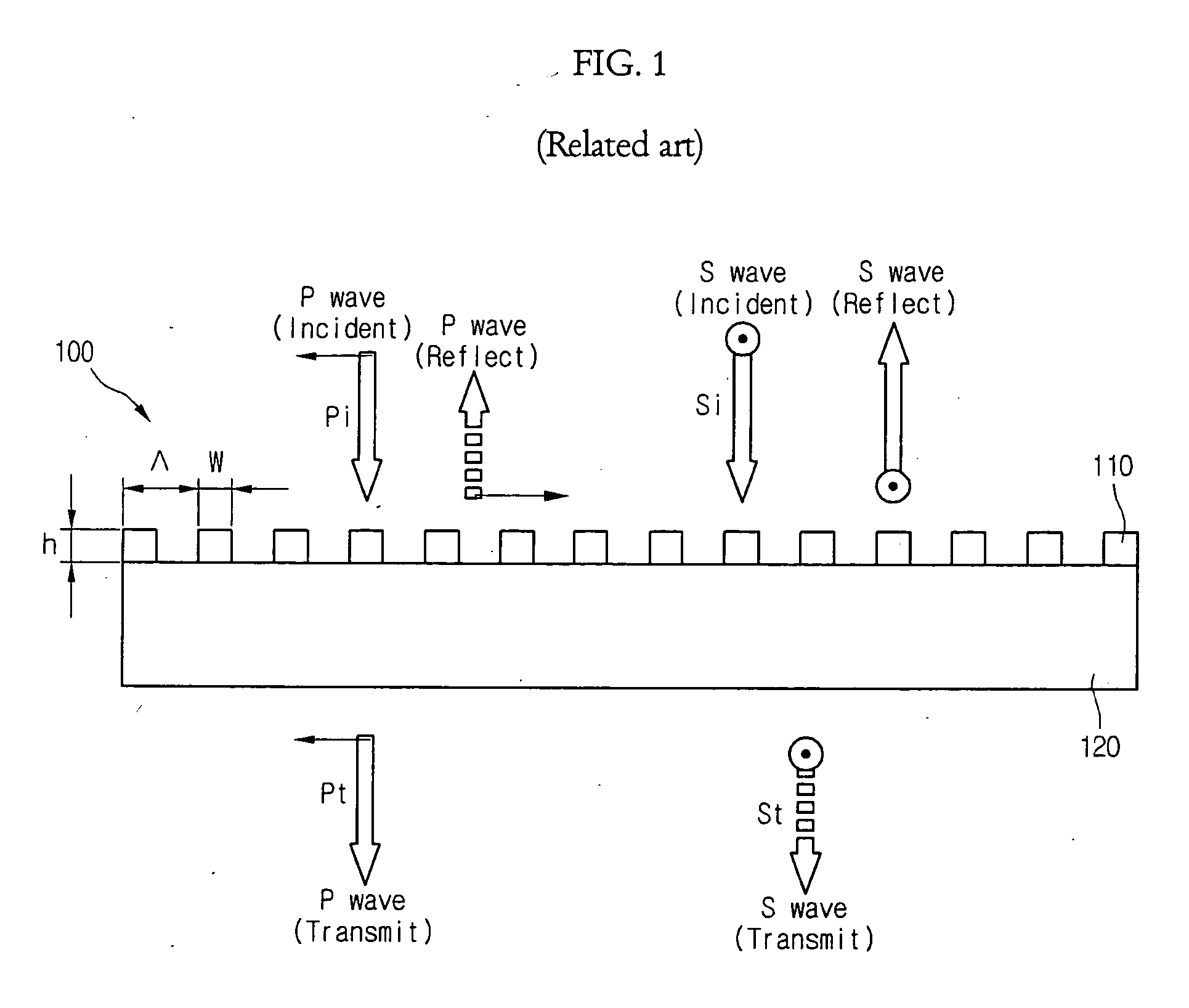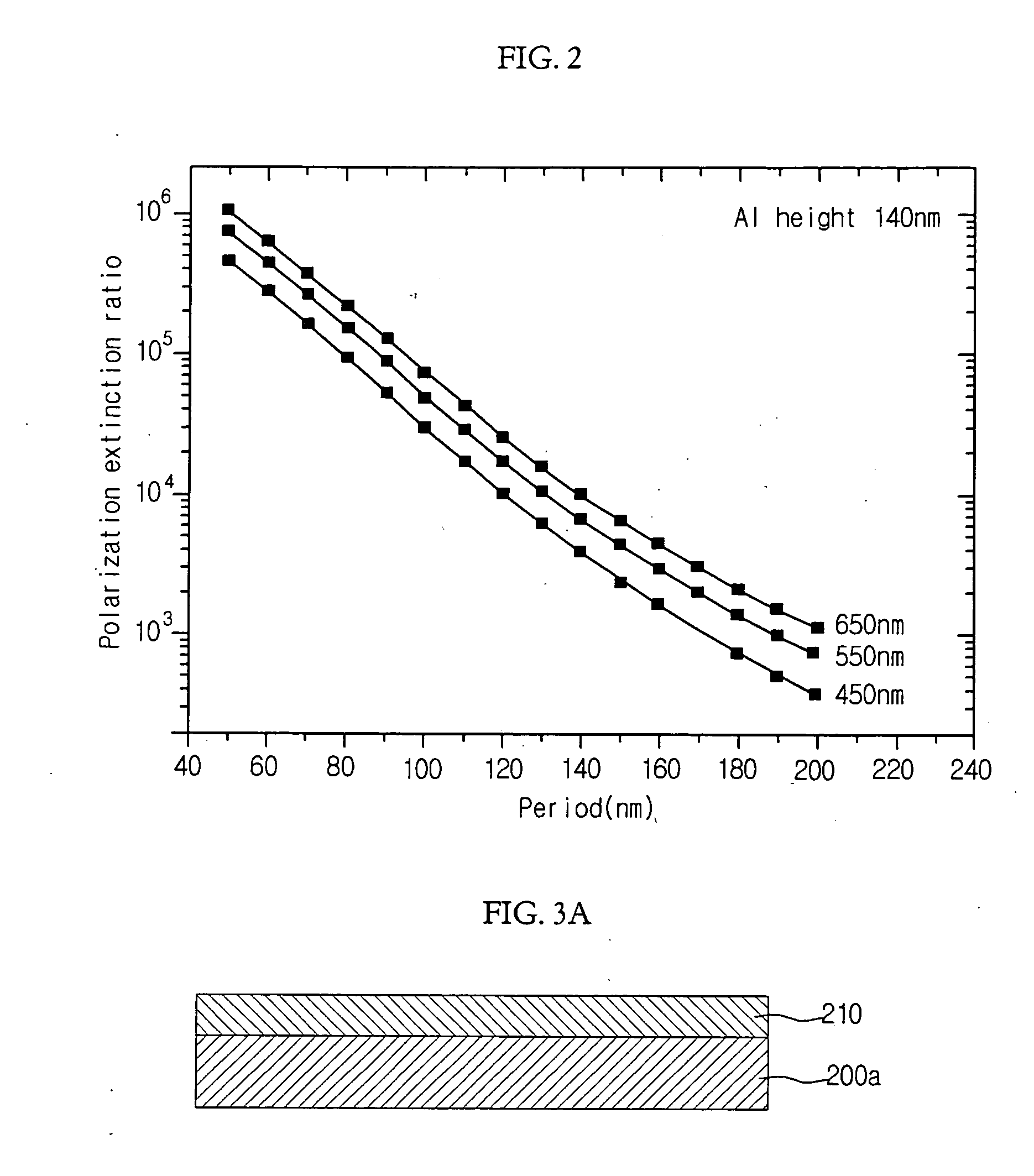Wire grid polarizer and manufacturing method thereof
a wire grid polarizer and manufacturing method technology, applied in the direction of polarizing elements, instruments, applications, etc., can solve the problems of difficult to manufacture wire grid polarizers with a shorter period of wire grid, plain glass does not transmit 100% of incident light, etc., to achieve easy and repeated manufacturing and excellent polarizing performance
- Summary
- Abstract
- Description
- Claims
- Application Information
AI Technical Summary
Benefits of technology
Problems solved by technology
Method used
Image
Examples
first embodiment
[0065]FIGS. 4A to 4H illustrate a sequence of a manufacturing process of a wire grid polarizer, according to the present invention.
[0066] As described before, the wire grid polarizer is manufactured by using the pre-made mold. To this end, a transparent glass substrate 300 with both surfaces polished is first prepared (refer to FIG. 4A).
[0067] Then, as shown in FIG. 4B, a thin metal foil 310a is deposited on the glass substrate 300.
[0068] The metal foil 310a can be made from Al, Ag, or Cr.
[0069] Later, the metal foil 310a is coated with a polymer 320a, as shown in FIG. 4C
[0070] The polymer 320a is pressed by the mold 330, and as a result, the pattern from the mold is printed onto the polymer 320a.
[0071] Here, if the polymer 320a is a thermosetting material, a metal mold is employed, and if the polymer 320a is a UV cure material, a transparent polymer mold is employed.
[0072] In the former case where the polymer 320a is a thermosetting material, the hot embossing technique is use...
second embodiment
[0083]FIGS. 5A to 5G illustrate a sequence of a manufacturing process of a wire grid polarizer, according to the present invention.
[0084] As explained before, the wire grid polarizer is manufactured by using the pre-made mold. To this end, a transparent glass substrate with both surfaces polished is first prepared (refer to FIG. 5A).
[0085] Later, as shown in FIG. 5B, the glass substrate 400 is coated with a polymer 410a, and the mold 430 is prepared.
[0086] Then, the polymer 410a is pressed by the mold 430, and as a result, the pattern from the mold 430 is printed onto the polymer 410b, as shown in FIG. 5G
[0087] The pattern printed onto the polymer 410b is opposite to the pattern from the mold 430.
[0088] As shown in FIG. 5D, by applying heat or irradiating ultraviolet light onto the mold 430, the polymer 410b is cured or solidified
[0089] In case of using the hot embossing technique, the mold 430 has to be separated from the polymer 410b after the temperature of the substrate 400 ...
PUM
| Property | Measurement | Unit |
|---|---|---|
| wavelengths | aaaaa | aaaaa |
| width | aaaaa | aaaaa |
| photosensitive | aaaaa | aaaaa |
Abstract
Description
Claims
Application Information
 Login to View More
Login to View More - R&D
- Intellectual Property
- Life Sciences
- Materials
- Tech Scout
- Unparalleled Data Quality
- Higher Quality Content
- 60% Fewer Hallucinations
Browse by: Latest US Patents, China's latest patents, Technical Efficacy Thesaurus, Application Domain, Technology Topic, Popular Technical Reports.
© 2025 PatSnap. All rights reserved.Legal|Privacy policy|Modern Slavery Act Transparency Statement|Sitemap|About US| Contact US: help@patsnap.com



